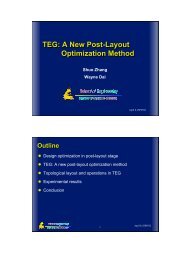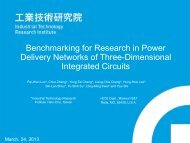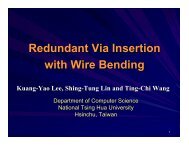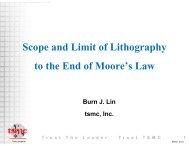slides - ISPD
slides - ISPD
slides - ISPD
Create successful ePaper yourself
Turn your PDF publications into a flip-book with our unique Google optimized e-Paper software.
Stochastic Analog Circuit<br />
Behavior Modeling by Point<br />
Estimation Method<br />
Fang Gong 1 , Hao Yu 2 , Lei He 1<br />
1<br />
Univ. of California, Los Angeles<br />
2 Nanyang Technological University, Singapore
Outline<br />
• Backgrounds<br />
• Existing Methods and Limitations<br />
• Proposed Algorithms<br />
• Experimental Results<br />
• Conclusions
IC Technology Scaling<br />
• Feature size keeps scaling down to 45nm and below<br />
90nm 65nm 45nm<br />
Shrinking<br />
Feature Sizes<br />
• Large process variation lead to circuit it failures and yield problem.<br />
* Data Source: Dr. Ralf Sommer, DATE 2006, COM BTS DAT DF AMF;
Statistical Problems in IC Technology<br />
• Statistical methods were proposed to address variation<br />
problems<br />
• Focus on performance probability distribution extraction in<br />
this work<br />
Fixed<br />
Value<br />
Design<br />
Parameters<br />
Random<br />
Distribution<br />
Process<br />
Parameters<br />
Parameter<br />
Space<br />
Mapping<br />
Circuit<br />
Performance<br />
Unknown<br />
Distribution<br />
Performance<br />
Space<br />
How to model the stochastic circuit behavior (performance)
Leakage Power Distribution<br />
• An example ISCAS-85 benchmark circuit:<br />
• all threshold voltages (Vth) of MOSFETs have variations that follow Normal<br />
distribution.<br />
• The leakage power distribution follow lognormal distribution.<br />
*Courtesy by Fernandes, R.;<br />
Vemuri, R.; , ICCD 2009.<br />
pp.451-458, 4-7 Oct. 2009<br />
• It is desired d to extract t the arbitrary (usually non-normal) distribution ib ti of<br />
performance exactly.
Problem Formulation<br />
• Given: random variables in parameter space<br />
• aseto of (normal) random variables ab {ε 1 , ε 2 , ε 3 , ...} to model process<br />
variation sources.<br />
• Goal: extract the arbitrary probability distribution of performance<br />
f(ε 1 , ε 2 , ε 3 , ...) in performance space.<br />
process<br />
variation<br />
mapping<br />
Variable<br />
performance<br />
Parameter Space<br />
Performance Space
Outline<br />
• Backgrounds<br />
• Existing Methods and Limitations<br />
• Proposed Algorithms<br />
• Experimental Results<br />
• Conclusions
Monte Carlo simulation<br />
• Monte Carlo simulation is the most straight-forward<br />
method.<br />
Device<br />
variation<br />
SPICE<br />
Monte<br />
Carlo<br />
Analysis<br />
Parameter Domain<br />
Performance Domain<br />
• However, it is highly time-consuming!
Response Surface Model (RSM)<br />
• Approximate circuit performance (e.g. delay) as an analytical<br />
function of all process variations (e.g. V TH , etc )<br />
• Synthesize analytical function of performance as random variations.<br />
• Results in a multi-dimensional model fitting problem.<br />
• Response surface model can be used to<br />
• Estimate performance variability<br />
• Identify critical variation sources<br />
• Extract worst-case performance corner<br />
• Etc.<br />
f<br />
f<br />
Δx 2<br />
<br />
<br />
<br />
p<br />
0<br />
<br />
1<br />
1<br />
Δx 1<br />
N<br />
<br />
N
Flow Chart of APEX*<br />
Synthesize analytical function<br />
of performance using RSM<br />
f<br />
<br />
<br />
<br />
p<br />
0<br />
<br />
1<br />
<br />
1<br />
<br />
<br />
N<br />
<br />
N<br />
Calculate moments<br />
Calculate the probability<br />
distribution function (PDF) of<br />
performance based on RSM<br />
h(t) can be used to estimate pdf(f)<br />
*Xin Li, Jiayong Le, Padmini Gopalakrishnan and Lawrence<br />
Pileggi, "Asymptotic probability extraction for non-Normal<br />
distributions of circuit performance," IEEE/ACM International<br />
Conference on Computer-Aided Design (ICCAD), pp. 2-9, 2004.
Limitation it ti of APEX<br />
• RSM based method is time-consuming to get the analytical function of<br />
performance.<br />
• It has exponential complexity with the number of variable parameters n and<br />
order of polynomial function q.<br />
f ( x , x , , x ) ( x x <br />
x ) q<br />
1 2 n 1 1 2 2<br />
n n<br />
• e.g., for 10,000 variables, APEX requires 10,000 simulations for linear<br />
function, and 100 millions simulations for quadratic function.<br />
• RSM based high-order moments calculation has high complexity<br />
• the number of terms in f k increases exponentially with the order of moments.<br />
k<br />
f ( x , x , , x ) ( x x <br />
x )<br />
1 2 n 1 1 2 2<br />
n n<br />
kq
Contribution of Our Work<br />
Step 1: Calculate High Order Moments of Performance<br />
APEX<br />
Find analytical l function of performance using RSM<br />
f p <br />
<br />
<br />
0<br />
1<br />
1<br />
N<br />
N<br />
Proposed Method<br />
A few samplings at selected points.<br />
Calculate high order moments<br />
<br />
<br />
<br />
k<br />
k<br />
m<br />
f<br />
( f pdf ( f )) df<br />
Calculate moments by Point Estimation Method<br />
Step 2: Extract the PDF of performance<br />
<br />
m<br />
k<br />
f<br />
<br />
<br />
k<br />
k<br />
M<br />
( 1)<br />
k<br />
k ( 1)<br />
k<br />
a<br />
1<br />
<br />
<br />
<br />
(<br />
f<br />
<br />
pdf<br />
(<br />
f<br />
))<br />
df<br />
<br />
mt<br />
<br />
<br />
<br />
(<br />
t<br />
<br />
h<br />
(<br />
t<br />
))<br />
dt<br />
<br />
<br />
k!<br />
k!<br />
b<br />
<br />
<br />
r1<br />
M<br />
k<br />
r<br />
b t<br />
h<br />
(<br />
t<br />
)<br />
<br />
<br />
a<br />
<br />
r <br />
k <br />
r<br />
e pdf ( f )<br />
1<br />
r<br />
r1<br />
• Our contribution:<br />
• We do NOT need to use analytical formula in RSM;<br />
• Calculate high-order moments efficiently using Point Estimation Method;
Outline<br />
• Backgrounds<br />
• Existing Methods and Limitations<br />
• Proposed Algorithms<br />
• Experimental Results<br />
• Conclusions
Moments via Point Estimation<br />
• Point Estimation: approximate high order moments with a<br />
weighted sum of sampling values of f(x).<br />
• are estimating points of random variable.<br />
• P j are corresponding weights.<br />
• k-th moment of f(x) can be estimated with<br />
PDF<br />
x 1 x 2 x 3<br />
• Existing work in mechanical area* only provide empirical<br />
analytical lti lformulae for x j and P j for first four moments.<br />
Question – how can we accurately and efficiently<br />
calculate the higher order moments of f(x)<br />
* Y.-G. Zhao and T. Ono, "New point estimation for probability moments," Journal of Engineering Mechanics, vol. 126, no. 4,<br />
pp. 433-436, 2000.
Calculate moments of performance<br />
• Theorem in Probability: assume x and f(x) are both continuous<br />
random variables, then:<br />
• Flow Chart to calculate high order moments of performance:<br />
pdf(x) of parameters is known<br />
Step 5: extract performance distribution pdf(f)<br />
Step 1: calculate moments of parameters<br />
m<br />
k<br />
x<br />
<br />
<br />
<br />
<br />
( x<br />
k<br />
pdf ( x))<br />
dx <br />
m<br />
<br />
j1<br />
P (<br />
x )<br />
j<br />
j<br />
k<br />
Step 4: calculate moments of performance<br />
m<br />
k<br />
f<br />
<br />
<br />
<br />
<br />
( f<br />
k<br />
pdf ( x))<br />
dx <br />
m<br />
<br />
j1<br />
P (<br />
f ( x ))<br />
j<br />
j<br />
k<br />
Step 2: calculate the estimating points x j<br />
and weights P j<br />
Step 3: run simulation at estimating points x j<br />
and get performance samplings f(x j )<br />
Step 2 is the most important step in this process.
Estimating Points x j and Weights P j<br />
• With moment matching method, and P j can be calculated l by<br />
m<br />
k<br />
Pj<br />
1<br />
mx<br />
j1<br />
m<br />
<br />
j1<br />
m<br />
<br />
j1<br />
<br />
P x E ( x ) <br />
m<br />
1<br />
j j x<br />
P x E( x ) m<br />
2 2 2<br />
j j x<br />
k<br />
• m ( k 0,..., 2m1)<br />
can be calculated exactly with pdf(x).<br />
x<br />
m<br />
<br />
j1<br />
P x E( x ) m<br />
2m 1 2m 1 2m<br />
1<br />
j j x<br />
• Assume residues a j = P j and poles b j = 1/ x<br />
j<br />
x j<br />
k m<br />
( 1)<br />
<br />
Pj<br />
<br />
k!<br />
j1<br />
f( x )<br />
j<br />
k<br />
• system matrix is well-structured (Vandermonde matrix);<br />
• nonlinear system can solved with deterministic method.
Extension to Multiple Parameters<br />
• Model moments with multiple parameters as a linear combination<br />
of moments with single parameter.<br />
• f(x 1 ,x 2 ,…,x n ) is the function with multiple parameters.<br />
• f(x i ) is the function where xi is the single parameter.<br />
• g i is the weight for moments of f(x i )<br />
• c is a scaling constant.
Error Estimation<br />
• We use approximation with q+1 moments as the exact value, when<br />
investigating PDF extracted with q moments.<br />
• When moments decrease progressively<br />
Magnitude of Moment (norma lized)<br />
m<br />
k<br />
f<br />
<br />
<br />
(<br />
<br />
f<br />
k<br />
<br />
pdf<br />
(<br />
f<br />
))<br />
df<br />
0 < f < 1<br />
Order of Moment<br />
• Other cases can be handled after shift (f1) or<br />
scaling operations of performance merits.
Outline<br />
• Backgrounds<br />
• Existing Methods and Limitations<br />
• Proposed Algorithms<br />
• Experimental Results<br />
• Conclusions
(1) Validate Accuracy: Settings<br />
• To validate accuracy, we<br />
compare following methods: MMC+APEX PEM<br />
Run Monte Carlo Point Estimation<br />
• Monte Carlo simulation.<br />
• run tons of SPICE<br />
simulations to get<br />
performance distribution.<br />
• PEM: point estimation based<br />
method (proposed in this work)<br />
• calculate high order moments<br />
with point estimation.<br />
• MMC+APEX:<br />
• obtain the high order<br />
moments from Monte Carlo<br />
simulation.<br />
• perform APEX analysis flow<br />
with these high-order<br />
moments.<br />
Calculate time<br />
moments<br />
Match with the time<br />
moment of a LTI system
6-T SRAM Cell<br />
• Study the discharge behavior in BL_BB node during reading<br />
operation.<br />
• Consider threshold voltage of all MOSFETs as independent<br />
Gaussian variables with 30% perturbation from nominal values.<br />
• Performance merit is the voltage difference between BL and BL_B<br />
nodes.
Accuracy Comparison<br />
• Variations in threshold voltage lead to deviations on discharge behavior<br />
• Investigate distribution of node voltage at certain time-step.<br />
• Monte Carlo simulation is used as baseline.<br />
• Both APEX and PEM can provide high accuracy when compared with MC<br />
simulation.<br />
PDF<br />
0<br />
bility of Occu urrence<br />
(Normalized d)<br />
Proba<br />
MC results<br />
Voltage (volt)
(2)Validate Efficiency: cy PEM vs. MC<br />
• For 6-T SRAM Cell, Monte Carlo methods requires 3000<br />
times simulations to achieve an accuracy of 0.1%.<br />
• Point Estimation based Method (PEM) needs only 25 times<br />
simulations, and achieve up to 119X speedup over MC<br />
with the similar accuracy.
Compare Efficiency: PEM vs. APEX<br />
• To compare with APEX:<br />
• One Operational Amplifier under a commercial 65nm CMOS process.<br />
• Each transistor needs 10 independent variables to model the random<br />
variation*.<br />
Circuit Name Transistor # Mismatch Variable #<br />
SRAM Cell ~ 6 ~ 60<br />
Operational Amplifier ~ 50 ~ 500<br />
ADC ~ 2K ~ 20K<br />
SRAM Critical Path ~ 20K ~ 200K<br />
• We compare the efficiency between PEM and APEX by the required<br />
number of simulations.<br />
• Linear vs. Exponential Complexity:<br />
• PEM: a linear function of number of sampling point and random variables.<br />
• APEX: an exponential function of polynomial order and number of variables.<br />
* X. Li and H. Liu, “Statistical regression for efficient high-dimensional modeling of analog and mixed-signal performance variations," in Proc.<br />
ACM/IEEE Design Automation Conf. (DAC), pp. 38-43, 2008.
Operational Amplifier<br />
• A two-stage operational amplifier<br />
• complexity in APEX increases exponentially with polynomial orders<br />
and number of variables.<br />
• PEM has linear complexity with the number of variables.<br />
Operational Amplifier with 500 variables<br />
Quadratic polynomial case<br />
~124X<br />
~124X<br />
Polynomial Order in RSM<br />
The Y-axis in both figures has log scale!
Conclusion<br />
• Studied stochastic analog circuit behavior modeling<br />
under process variations<br />
• Leverage the Point Estimation Method (PEM) to<br />
estimate the high order moments of circuit behavior<br />
systematically and efficiently.<br />
• Compared with exponential complexity in APEX,<br />
proposed method can achieve linear complexity of<br />
random variables.
Thank you!<br />
ACM International Symposium on Physical Design 2011<br />
Fang Gong, Hao Yu and Lei He












